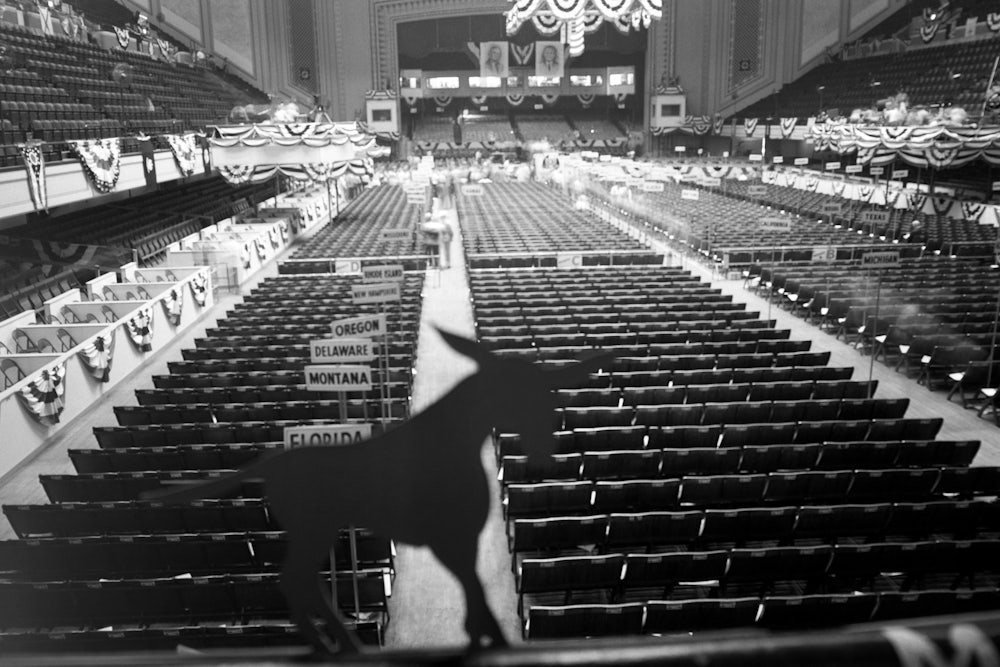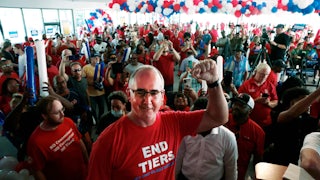What is a party for? A month of existential uncertainty—sparked by President Joe Biden’s catastrophic debate performance, and mercifully concluded when Biden withdrew and endorsed Vice President Kamala Harris—tested the institutional capacity of America’s oldest party. In that interregnum, alliances formed across ideological lines, with donors, left-leaning voters, and party elders applying public and private pressure to a recalcitrant Biden until he could hold out no longer; in the words of an anonymous Democratic source, the president was given “three weeks of the easy way. It was about to be the hard way.”
Over the same period, the RNC christened Donald Trump’s remaking of the Republican Party in his image. With his daughter-in-law, Lara, at the top of party leadership, the former president presided over a weeklong carnival celebrating his takeover of the GOP.

In both cases, the parties presented a weak counterbalance to the presidential candidates. In their new book, The Hollow Parties, political scientists Daniel Schlozman and Sam Rosenfeld warn of a process of decay decades in the making, tracing the rise and fall of the national party system. I recently spoke with Schlozman and Rosenfeld about the Democrats’ switch to Kamala Harris, the New Right’s long march through the GOP, and the future of the party system. Our conversation has been edited for length and clarity.
Ben Metzner: As the title of your book suggests, you describe political parties in the United States as “hollow parties.” What does this mean, and how did you land on the evocative metaphor of hollowness to capture what ails our politics?
Sam Rosenfeld: When we started working on this eight years ago we were prompted by contradictory and paradoxical things happening simultaneously with parties. Party discipline grew over this time in voting behavior in Congress. Party leaders in Congress, particularly on the Democratic side, but also on the Republican side, to a certain extent, have more centrality and clout than they did before. There has been a growth in formal parties at the national levels, and of fundraising capacity over time. So the competitive pressures of polarization leads to the party system being strong in a certain sense. And yet, even as parties are more ever-present than they have been before, there is this incapacity we see, evident in parties’ inability to take concerted collective decision-making, either internally, when it comes to nominations, when it comes to kind of setting priorities for an agenda for power, or externally, in helping to shape and influence the conflicts that are swirling around politics and society.
Daniel Schlozman: Things that are hollow superficially look like everything’s fine on the outside, and yet you drill inside and there’s a void.
B.M.: You write that hollow parties don’t just “enfeeble governance,” but also “endanger democracy.” Why?
S.R.: Political parties are this underappreciated, essential part of democracy as peaceful self-government. If you want peaceful self-government, the peaceful transfer of power through elections, you need political parties that can actually function to organize that.
D.S.: Democracy is not judges and the rule of law only; it is people together deciding what kind of country do we want to be, and having visions for it and thrashing it out. That collective experience of doing politics is democracy.
B.M.: Democrats and Republicans seem to embody this hollowness in different ways.
D.S.: Republicans have concerns about extremism. They have been unable to resist the snares of nonparty actors who have broken through the traditional fetters of party. For Republicans, hollowness is much more an inability to mount a collective project.
For Democrats, the story is ineffectuality. Democrats are unable to come together across a big, diverse party in common purpose and figure out what they want to be as a party, whose ox will get gored, who will lead the party, tasks of coordination, and not just coordination, but setting forth a coherent sense of what they want to do and wielding state power. It’s been very difficult for the post–New Deal party.
S.R.: There is a conservative movement that we formulate as the Long New Right, spanning across the postwar decades and to the end of the century, that is defined in and of itself less by an ideological project that is coherent and a set of policy prescriptions, but rather by an approach to all political institutions, rules, and norms that is extremely instrumental and mercenary. The project has been entirely negative and pugilistic, about mobilizing group conflicts to take power across decades.
On the Democratic side, it’s much more a story of the breakup of the New Deal order, which had its own contradictions, a set of conflicting impulses and incentives. There’s a need to raise money. There are organizational needs that run at some cross-purposes with traditional ideological and programmatic needs. There is a very diverse and changing set of demographic constituencies that underlie the party.
B.M.: You devote a section in the book to the rise of the Long New Right as a key to understanding the hollowness of the GOP, and write that modern conservatism both hollowed out and polarized the American party system. Can you explain that paradox?
D.S.: On the one hand, the Long New Right is defined by its enemies, much more than by its own ideological coherence. And in that sense, I think we have a slightly different gloss from others who have studied the right, that the thinkers are really important, but the thinkers are important as they name enemies rather than as they proposed a positive project. Those enemies are both the forces of communism through New Deal liberalism, but they are also internal enemies in what they define as the supine Republican Party. The Republican Party, according to one New Right figure, is just a place where rich people go to pick their noses. They want to supersede parties entirely by building single-issue coalitions that will supplant the traditional moribund nose-pickers parties. And that those single-issue coalitions coordinated by the New Right, funded by direct mail, will see a country that is much more polarized, with conservative single-issue New Right groups as the dominant players, rather than a party that they see as completely ineffectual.
B.M.: It seems that a lot of the panic among Democrats in recent weeks has stemmed from an uncertainty about the party’s ability to influence the top of the ticket. How should we interpret Biden’s decision to withdraw from the race and endorse Vice President Kamala Harris?
D.S.: Presidents are not entirely unaccountable to their parties, and under extreme conditions, parties can decide that they want a different standard-bearer. These are pretty extreme conditions, and the process by which this happened is the opposite of systematic and coordinated, with a huge amount riding on the person of Nancy Pelosi, now no longer in any kind of formal role.
The Democratic National Committee itself was Biden loyalists all the way down and not involved in this coordination. I know the signaling was pretty erratic. So, as far as we can tell, this is not the mark of a disciplined party. It’s a party that somehow got everything right.
That everyone has fallen in line so quickly behind Harris is, a lot of ways, a reflection of the same kind of forces that kept Biden from being challenged in the first place, namely that it’s very hard to mount a strong faction challenge either from the left, or from the right, to this administration. The coordination that’s happened, once Harris has been anointed without a challenger from the left or the right, is not so much the sign of an effective party as that it’s very hard to oppose a sitting vice president, once that person has got the presidential endorsement.
More broadly, if a metric for an unhollowed party is any sign of coordination whatsoever, then a process that is rushed, shambolic, incomplete, where it’s not really clear who was leading whom, and that relies a lot on one person, is evidence of some kind of coordination. But if you imagine parties as capable of much more systematic thinking on their own behalf, then that leads you to much more of a glass-half-empty story than a Look they did it, parties are all in order, glass-half-full story.
B.M.: What do thriving, renewed Democratic and Republican Parties look like?
S.R.: On the Democratic side, we see as a case study Nevada in the twenty-first century: a party that is both formally really strong and professional and invests resources in actually having a formal party apparatus, that has this kind of high morale and high quality, and then also maintains robust connections to important thriving social movements. A lot of this has to do with kind of renewing parties along with renewing civic organizations across the board, like in the case of Nevada, labor unions, the culinary workers in Las Vegas.
And on the Republican side, we grapple with the danger of the grassroots, robust civic parties that are also fascistic or antidemocratic and dangerous. And how you go about reviving a much more tempered and partial and moderate Republican tradition, which does exist, is a much harder nut to crack.






